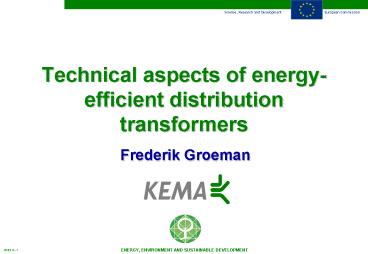Technical aspects of energyefficient distribution transformers PowerPoint PPT Presentation
1 / 20
Title: Technical aspects of energyefficient distribution transformers
1
Technical aspects of energy-efficient
distribution transformers
- Frederik Groeman
2
Technical aspects of energy-efficient transformers
- Energy efficiency of distribution transformers
- Technological feasibility of energy-efficient
transformers - Economics of energy-efficient transformers
3
Distribution transformer efficiency standards
Source CENELEC
4
Standard transformer lossesat full load - HD 428
(538)
5
Energy losses in distribution transformers
- Dependent on design and use
- No-load losses (iron losses)
- Load losses (copper losses)
- Standard levels in HD 428 A-AC-C
- A mixed population throughout Europe
6
Efficient transformer designs
- No-load losses
- core material (e.g. high-grade steels, amorphous)
- core section
- core design
- Load losses
- increased conductor section
- lower temperature
- Even the lowest HD428 loss level does not require
technical specialties
7
Building distribution transformersmore
energy-efficient?
(technological)
No big ? problem!
8
From nameplate losses toactual lossesthe
effect of loading
9
From nameplate losses to real energy losses
- No-load losses (iron losses)
- voltage dependent
- always present, 8760 hours per year
- 1 kilowatt no-load loss ? 8760 kWh per year
- Load losses (copper losses)
- load dependent
- kilowatt load loss ? e.g. 2000 kWh per year
- Load power factor, harmonics
10
Transformer efficiency
400 kVA, efficiency level A-A (HD428)
11
Efficiency _at_ low load
400 kVA, efficiency level A-A (HD428)
12
Examples of loaded transformers
- 100 kVA transformer
- A-A
- nameplate 97.7
- yearly basis 94.7
- C-C
- nameplate 98.1
- yearly basis 96.5
- 400 kVA transformer
- A-A
- nameplate 98.5
- yearly basis 98.0
- C-C
- nameplate 98.8
- yearly basis 98.6
13
Energy-efficient application of distribution
transformers
- Match the transformer design to the load
- peak load
- running time of peak load
- Avoidance of over-excitation
- Always a compromise
14
Economic aspects
- A balance between purchase cost and energy losses
- Loss evaluation as an alternative to standard
loss values
15
Loss evaluation
- Purchase costs
- Load losses
- No-load losses
16
Capitalised cost of a transformer
CC Ct APo BPk
- Application data
- A cost no-load losses (/W)
- B cost of load losses (/W)
- Transformer data
- Ct purchase price ()
- Po no-load loss (W)
- Pk load losses (W)
17
Application of capitalised cost
- Selection of the best (cheapest) transformer
- A and B reflect NPV of purchase costs of energy
for the owner - B also reflects the load pattern
- Low A/B values favour cheap transformers
- High A/B values favour efficient transformers
- The European standards leave some freedom for
deviations
18
A and B values for selected countries
19
Two 400 kVA designs
No-load losses 4 /W, load losses 1.2 /W
20
Conclusions
- Efficiency can be significantly increased at a
price premium - Fit transformers to their load
- Losses are typically as expensive as the
transformer itself - Kyoto commitments
- Take lifetime costs into account, not just first
costs

